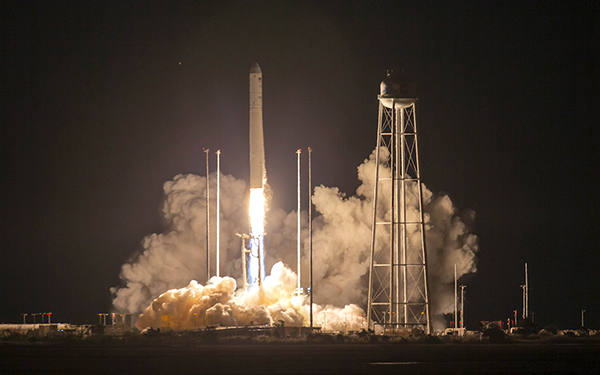2020 News & Events
POPS delivered to the International Space Station
8 October 2020
adapted from the story by NOAA Communications

POPS will help monitor air quality in crew quarters.
A miniaturized aerosol spectrometer developed by scientists in the NOAA Chemical Sciences Laboratory (CSL) reached new heights on Monday, October 5 when it was delivered by a cargo capsule to the International Space Station (ISS) orbiting more than 250 miles above Earth's surface. The Portable Optical Particle Spectrometer (POPS) will help monitor air quality in the main living area of the space station.
Developed by NOAA physicist Ru-Shan Gao, POPS uses an on-board laser to measure and count aerosol particles between 140 nanometers to 2.5 micrometers in diameter. A micrometer is 1/1000th of a millimeter. A nanometer is 1,000 times smaller than that. At six inches long and 1.3 pounds, POPS is about one tenth the size and one fifth the cost of comparable instruments.
The instrument was integrated into Aerosol Dynamics Inc's Ambient Particle Monitor, and ferried to the space station along with four tons of science experiments, crew supplies and station hardware on the Cygnus resupply capsule carried on an Antares rocket launched from NASA's Wallops Flight Facility on Wallops Island, Virginia.
In a spacecraft cabin environment, the size range of indoor aerosols is much larger and they persist longer than on Earth because they are not removed by gravitational settling. High concentrations of inhalable particles on the space station may be responsible for crew complaints of respiratory and eye irritation and comments about 'dusty' air reported to NASA. POPS will participate in a flight experiment which will provide data on floating particulate matter in the air inside the space station. Samples will be returned to Earth for chemical and microscopic analyses and will provide the first look at aerosol composition in the spacecraft.

The small size and light weight have earned POPS another high-flying mission in 2021. The instrument will be incorporated as a science payload launched by the Arizona company World View, for a series of high-altitude, long-duration flights aboard the company's "Stratollite" balloons for a uniquely detailed look at the composition of Earth's stratosphere.
Stratospheric particles, or aerosols, play a key role in moderating Earth's climate system by scattering or reflecting sunlight as it nears the surface and by modifying the formation of clouds. The stratosphere also holds the Earth's protective ozone layer, which absorbs ultraviolet radiation that can damage cellular structure, increase the risk of skin cancer and cataracts, and suppress the human immune system. Aerosols in the stratosphere act as surfaces for chemical reactions to occur, such as those that lead to depletion of the ozone layer.
The size range of particles that POPS can detect is particularly important for understanding the climate since they are both small enough to accumulate in the atmosphere instead of settling out, and large enough to efficiently reflect sunlight. The data will play a role in helping NOAA to understand baseline conditions in the stratosphere.
POPS has also been successfully transitioned to the commercial sector. In 2015, Dr. Gao disclosed the POPS to the NOAA Technology Partnerships Office (TPO), which filed a provisional patent application on the technology in June 2015. Later that year, TPO signed a non-exclusive license to commercialize the device with Handix Scientific of Boulder, Colorado.